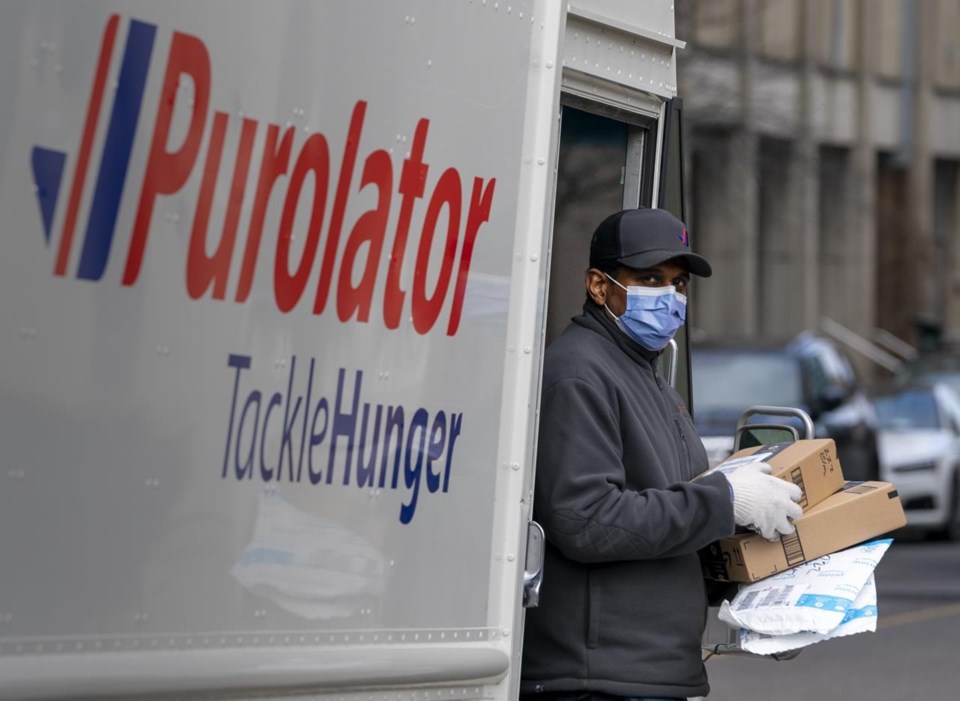CALGARY — The risk of catching COVID-19 from packages delivered to doorsteps is believed to be low, but a health expert says taking a few extra steps when handling it can diminish the risk even more.
Canadians are using delivery services more during the pandemic not only because many stores are closed, but also to avoid physical contact with people.
Some companies who ship have been hit by the virus, however.
Staff at Purolator and Amazon distribution centres in the Calgary area have tested positive for COVID-19.
There have been 36 people infected at Purolator in Calgary and nine at an Amazon Fulfillment Centre north of the city as of Wednesday, according to Alberta Health.
Studies on coronaviruses, such as the one that causes COVID-19, have determined the virus can survive longer on hard plastic and metal than on porous paper, cardboard, cotton and wool in room temperatures.
The range for cardboard and paper, which are standard materials for delivery boxes, is thought to be usually less than 24 hours but also up to five days.
"The risk is unknown, but assumed to be low," said Dr. Chris Sikora, medical officer of health for the Edmonton zone of Alberta Health Services.
"Most of the packages we receive are cardboard and paper-based and survivability is relatively low. It is an inhospitable environment for the virus overall as those packages are transitioning in our Canadian environment."
Standard advice from public health officials applies when bringing a package inside, he said, which is wash your hands and don't touch your face.
"You can safely bring in these packages," Sikora said. "Wash your hands before you open packages and definitely after.
"If people want to, it would be perfectly reasonable to wipe down the exterior surfaces of packages with a damp cloth with cleaning solution on it.
"You can always clean your kitchen counter or your office desk afterwards."
A coronavirus can last five days or more on plastic or metal, according to a table provided by Alberta Health Services.
"Most of the environmental contamination and transfer has been when people are in the same space and there's high-touch surfaces that people have been using," said Alberta's chief medical officer, Dr. Deena Hinshaw.
Purolator said in a statement to The Canadian Press the majority of cases at the Calgary site were "inside sortation" workers.
"All of our employees who have tested positive are away from work and self-isolating," the company said. "All of the positive cases have been out of the building for at least seven days."
Employees are subject to temperature checks and health screens before they can enter the building, Purolator added.
Sanitation and social-distancing measures are in the place, and the company said it is using contact tracing to contain the risk of further spread.
The Amazon warehouse in Balzac, located 19 kilometres north of Calgary, employs over 1,000 people.
"We are supporting the individuals who are recovering," Amazon spokesperson Lisa Guinn said in an email. "We are encouraging those who are unwell to stay home and taking extreme measures to keep people safe in our buildings.
"We have worked closely with health authorities to proactively respond, ensuring we continue to serve customers while taking care of our associates and teams."
Amazon said in a statement it will spend more than $800 million on COVID-19 safety and sanitation measures this year, including purchases of masks, hand sanitizer, gloves and installations of hand-washing stations at warehouses.
But a Canadian software developer resigned from his job as an Amazon vice-president last week over what he said is the firing of employees who lobbied for better COVID-19 protection in the company's warehouses.
Tim Bray wrote in a blog that he "quit in dismay at Amazon firing of two whistleblowers who were making noise about warehouse employees frightened of COVID-19.''
Amazon said it supports employees' rights to criticize working conditions, but that the two employees were fired for "repeatedly violating internal policies."
This report by The Canadian Press was first published May 7, 2020.
— Follow @DLSpencer10 on Twitter
Donna Spencer, The Canadian Press



